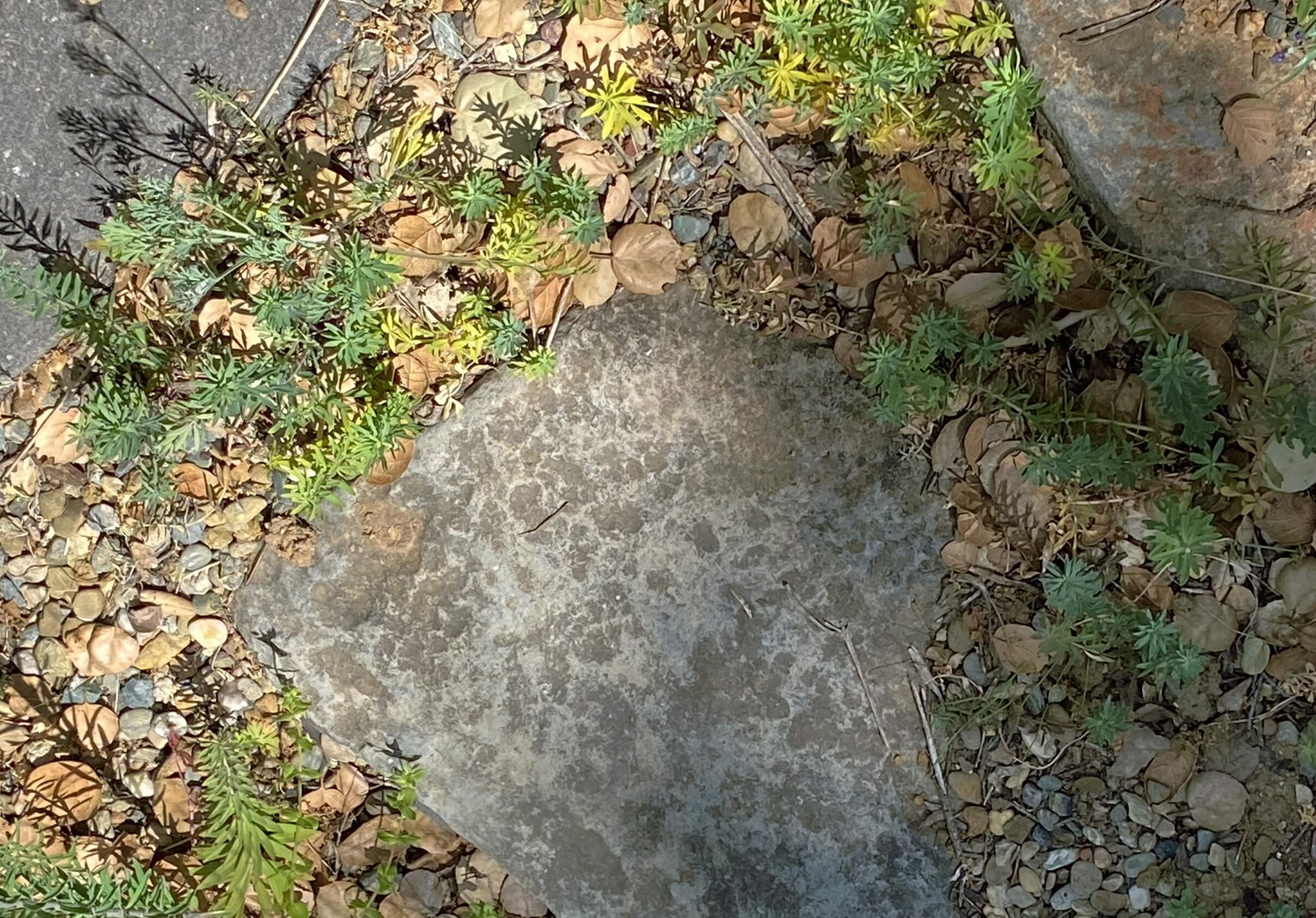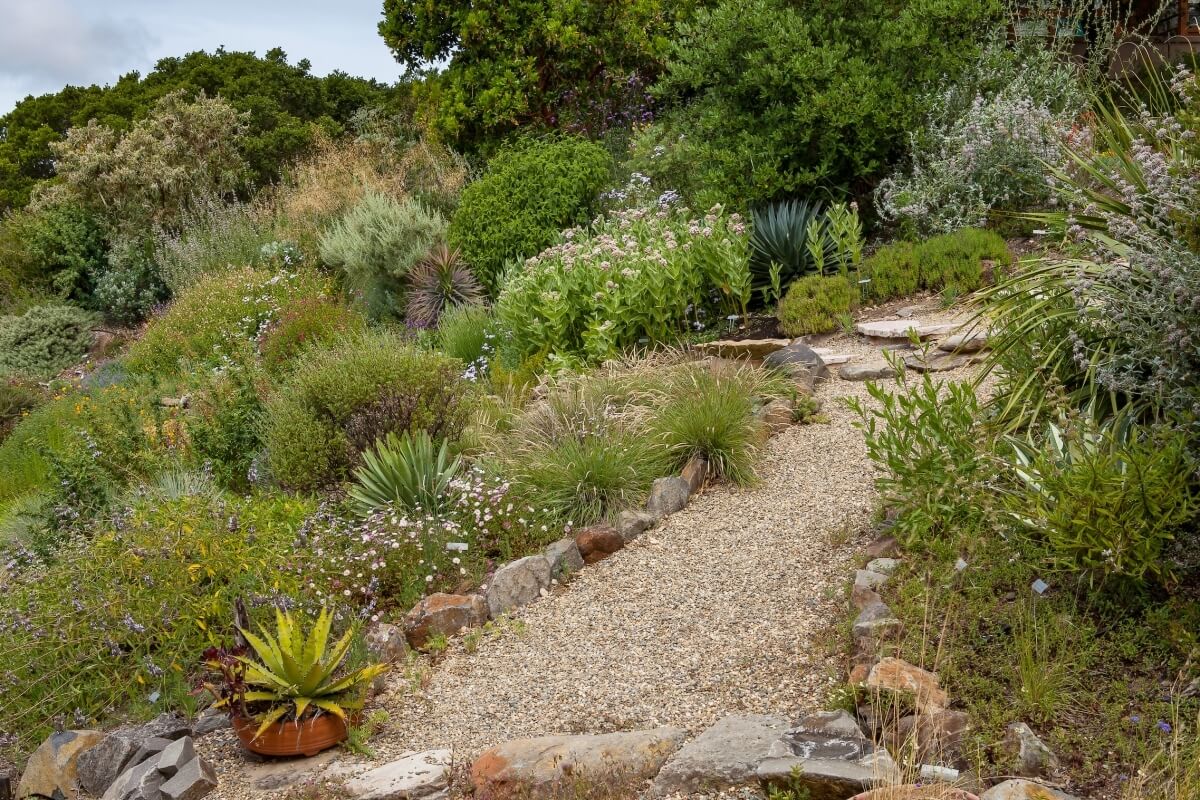While out walking the trails and open spaces in various parts of Marin County, I’m often astonished at how certain native plants can grow and adapt very nicely to a variety of exposures, habitats, and communities. Coffeeberries, for example, grows in shady California bay forests, in dry oak woodlands, upslope from streams in riparian zones, or in chaparral and coastal scrub. Other natives, such as cream bush, California lilacs, sticky monkeyflower, California sagebrush and California bee plant also thrive in a variety of habitats and exposures.
These traits can make it difficult and confusing to determine where is best to place natives in a cultivated garden. Some native species simply do not grow well in cultivation, and may not even be available in the nursery trade, while others are very amenable to garden culture. Other natives are quite adaptable after they become established, and simply start seeding themselves around. I love it when I see it happening in my own garden, and as much as possible I’ll let those plants grow where they want to—usually they thrive in their self-chosen locations!
My ultimate goal is to let my garden blend into the woodlands around my property and need very little tending from human hands. I have a number of criteria that help me select the plants I want to include in my landscape, which has a personal emphasis on creating habitat. This process can be very helpful to anyone starting on a new garden design, or, taking on a garden with some plants already established.
I ask myself:
• Can my oak woodland or the dry, chaparral-like area out in front of the house provide this plant with its needs?
California’s floristic province is huge, with about 6,000 species, and many of the plants native to other parts of the state are adaptable to Marin gardens, with special attention to placing the plant. Many beautiful plants are native to the Channel Islands, and given the right place to grow, blend in very nicely with natives from around the Bay Area.
• Does this plant increase biodiversity and provide additional resources for the other creatures I share my hill with?
I love the Ghost Pines; They always remind me of our favorite summer camping destinations, and when we start to see them I know we’re close! Blue Oaks and Ghost Pines often grow together and both are endemic to California. Blue Oaks grow naturally on our Novato hillside, at the very southern reaches of their territory, but we have no pines so I felt fine introducing the Ghost Pines. I collected seed at Lake Pillsbury in Mendocino National Forest, and grew several specimens, the largest of which is now about fifteen feet tall, and this summer is developing its first cone!
• Are there other plants in the same genera, or related species from other parts of California or Mediterranean climates in other parts of the world, that would be happy growing on my property?
I adore salvias. Here in Marin there is only one California species that grows naturally, but many more come from the southern part of the state. These are beautiful plants, many of which adapt very nicely to garden culture. There are also many more, both beautiful and unusual, from other Mediterranean climates that are adaptable to Marin gardens. I grow about sixty different species, selections and cultivars. I love them, and so do Anna’s hummingbirds!
• Will this plant provide desired tree-ripened fruits, or other foods or resources that are beneficial for my family?
There is one other reason that I, and many other gardeners also, want a particular plant in their home or garden.
• Does this plant have a strong nostalgic or emotional connection for me?
Most human beings respond to beauty; some flowers are incredibly beautiful or powerfully fragrant and these can be factors that often feed the soul. To a plant lover, a certain plant (or plant cutting) that was a gift from a special person, or reminds us of a particularly well-loved place, may have powerful personal meaning. Every time I look at the beautiful begonia growing nicely in a container on my front doorstep, I think fondly of my dear friend Paul, who has been gone for twenty years but, in a way, is still here!
My front garden faces south and gets sun all day. Photo: Saxon Holt
My husband and I have lived in the same home for sixteen years now, but the oldest parts of my garden are just fifteen years old now. I spent the first year walking our new property, paying attention to the existing natural elements of our land. I wanted to find the natural passages through the landscape the way the deer do, and then these became my major pathways. I also thought about the best places for the functional elements of a garden: where to place fruit trees and beds for vegetables and kitchen herbs and various compost piles or bins.
I looked for the naturally beautiful spots under the sheltering limbs of old oaks, the sunny spots in the canopies, or a particularly lovely view of the ridge opposite our hillside. I tried to tune into places on the property that just felt good to go to, and thought about including turns and curves in the pathways that would add a little mystery, and a sense of discovery, to a final destination. I kept in mind that destination spots could be created with peaceful and comfortable places to sit outside, perhaps to watch the activity at a birdbath, fountain, or nesting box, or a secluded corner in which to contemplate an interesting piece of sculpture or a found natural treasure.
I also made lists and notes about all the plants already existing on our land or in the surrounding native plant communities and associations. I referred to lists of plant within the related community (in my case, an oak woodland) and work to increase the biodiversity by adding more plants from that community, by creating special microclimates, or enhancing other habitat factors. I like to think about this process as a way of creating my own personal “ecosphere.”
I had already determined that only some of my garden borders and beds would be irrigated, but not the majority of our property. Areas closest to our house were developed first, and then bit-by-bit, in a really organic process, the rest of the garden evolved. My hillside clay in all the areas destined to be planted was gradually converted to a much more friable soil through a process of sheet mulching, using layers of cardboard, all-green compost, and rice straw. Composting in place like this, and especially when done months ahead of planting time, really kick-starts the process of creating healthy soil, which retains moisture, builds up available plant nutrients and deters many plant pathogens. All planted areas receive a top-dressing of compost or mulch on a regular, recurring basis.
I only plant natives in un-irrigated areas during the cool, rainy season, and I help the plants establish with occasional deep watering for the first three summers. I locate the water drainages on my hillside property, and slow and spread rainwater with shallow swales and small berms laid out on contours of the land, and then place the plants along these contours, giving these plants the best opportunities to naturalize in their new environment.
Throughout this process, I appreciate the fact that Marin County is among the most beautiful of places within the state of California, which in itself is one of the most unique places in the whole world! In our state, we have the largest living organisms, our giant Sequoias; the tallest trees, our Coast Redwoods; and the oldest living organisms, the Bristlecone Pines.
The incredible biodiversity of California (and Marin County, a biodiversity “hot spot”) is well worth preserving and protecting—something that those of us with land to steward can practice on a small, personal scale. Through that practice, I hope we can influence others to do the same with their own lands.



